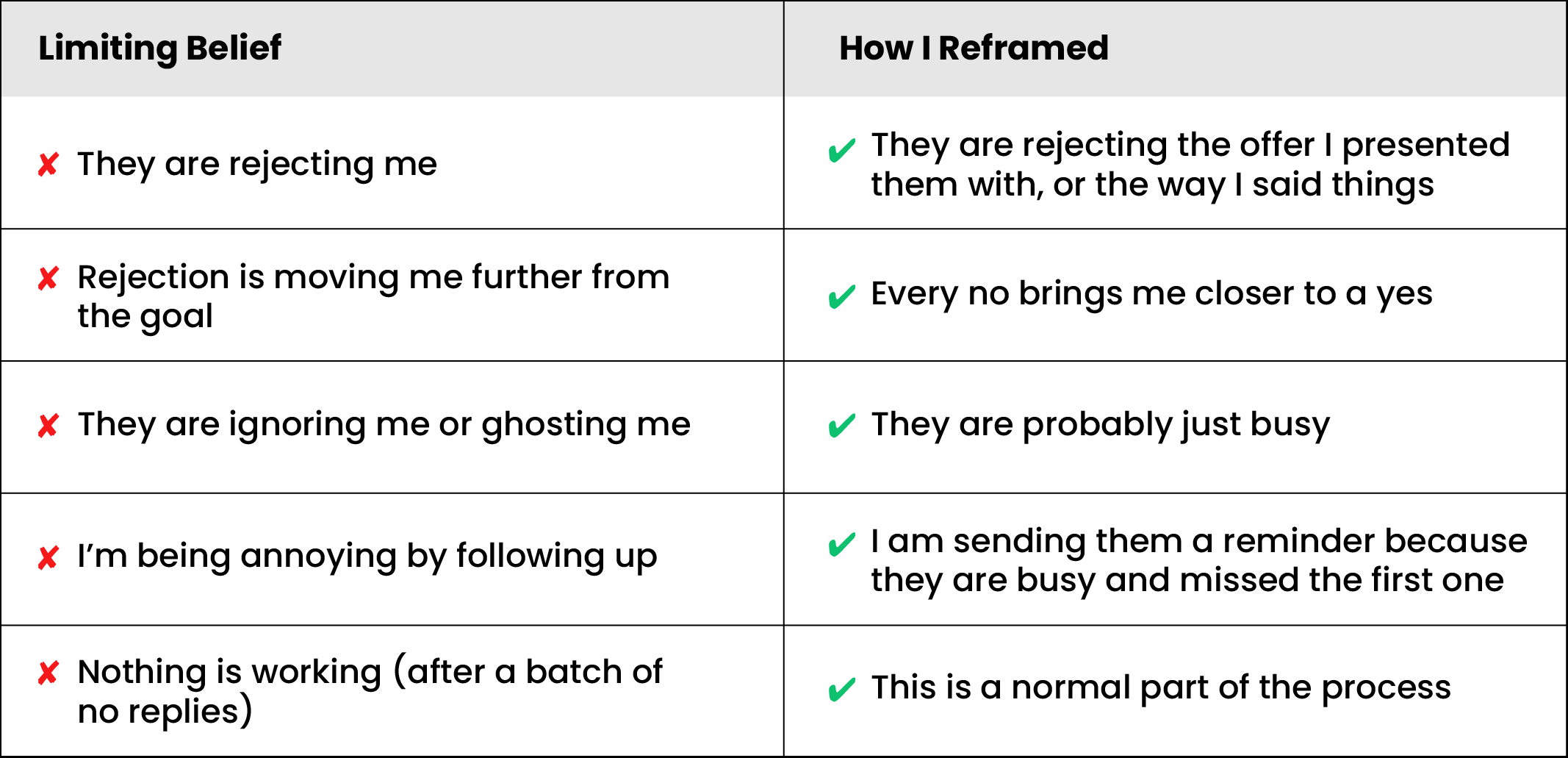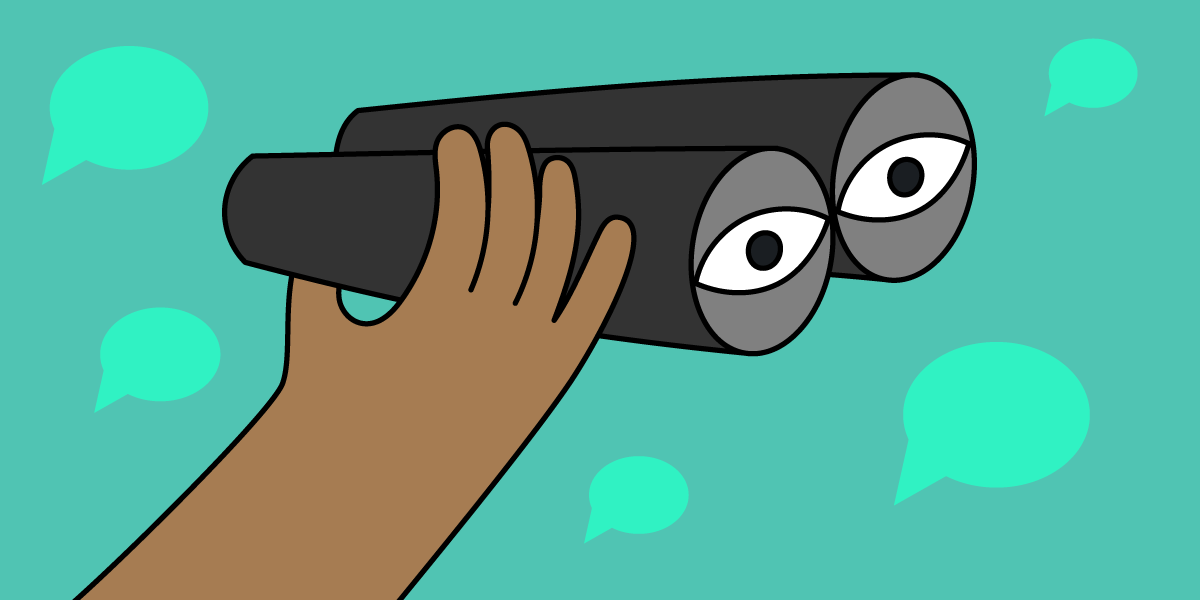
Cold outreach is one of the simplest and most effective ways to get clients and customers for a business.
It’s also a method most people refuse to use, even if they have next to no customers or clients for their business.
People avoid cold outreach because it forces you to deal with the emotions, belief systems, and situations most of us spend our entire lives trying to avoid:
- Rejection: You will get told no ten times more than you get told yes, and that’s being conservative
- Boredom: The act of doing cold outreach itself is tedious, repetitive, and boring
- Delayed gratification: In theory, it makes sense that you can send 1,000 messages and get a client. In practice, it’s difficult to send message 836 without having gotten a single bite.
At this point in my life, I have sent thousands of outreach messages and have used them to make hundreds of thousands of dollars.
I’m going to share the lessons I’ve learned about rejection, grit, and reputation, so you can draw inspiration from them and gain the courage to give cold outreach a genuine shot…which will help you ultimately grow your business, make connections, and expand your network.
Related:
The catch-22 you must solve to do more cold outreach
The number one roadblock to success with cold outreach is fear of rejection.
To overcome your fear of rejection, you have to get rejected so many times that you stop caring. But you’re often unable to put yourself in a position to get rejected because you’re afraid to get rejected.
So, how do you get over it?
You get over the rejection you’ll experience when you do cold outreach by reframing what rejection means to you.
Here are some of the reframes that have helped me change my relationship with rejection:
I remember one time I sent a cold outreach message to a Twitter influencer with whom I ended up doing a five-figure deal.
I sent him a casual follow-up to my first message. You know what he said in response?
“Thanks for following up with me, man, I was just busy.”
Imagine if I gave up because I thought I was being ignored or ghosted.
I would’ve missed out on $10,000+ all because of a story I made up in my mind that had no basis in reality. Fear of rejection is fueled by thinking we can read minds and assuming the worst.
If you want to get good at cold outreach, it’s important to understand that the story you tell yourself about rejection—the one where people who say no hate you and think you’re a loser for even trying to reach out in the first place—simply isn’t true.
Use the WIIFM principle to land clients (without looking like a scammer)
You can do cold outreach without looking like a spammer or ruining your reputation as long as you do one thing.
You need to have empathy for the people you are talking to and imagine what it’s like to be them.
Let me show you an example of a real cold pitch I got once:
I do about 55k a mo. with my staffing agency, just switched from stripe to whop after they held my money for the 3rd time. Whop will fly you out to NYC after processing 10k in 30 days and put your name on a times sq billboard, they let you offer financing to clients (6mo to 24mo) which helps you close more deals
Let me know if you want me to send you a quick loom with all the features its nuts..(yes im an affiliate lol they pay 30% lifetime on processing fees)
What do you notice about this cold outreach message?
It’s all about what’s in it for me.
- Relevant pain point: Stripe has been known to seize people’s accounts for no reason and give no explanation
- Relevant benefit: I can make more money if I can provide clients with financing if they can’t afford the pay-in-full option
- Cool bonuses and incentives: My name on a billboard and getting flown out to NYC for free? Yes, please!
- Addresses skepticism: He’s honest about why he is doing this and what’s in it for him. And both of our interests are aligned.
- Low-risk ask: He didn’t even ask me to commit right away. He asked for a small commitment to the next step, which was to watch a quick video explaining how things work
Let’s compare this with one of the many random cold outreach messages I get in my inbox daily:
Fair if I share more info?
The main problem with this cold outreach message? I don’t run an e-commerce store.
This happens all the time on X. People send spam cold outreach messages without taking the time to research the people they’re talking to.
This gives everyone who does cold outreach a bad name and scares people off from doing it.
You can send outreach messages without ruining your reputation at all with just a little bit of homework and the ability to answer the question:
“What’s in it for me?”
With “me” being the person you’re reaching out to.
I’m a business owner. Don’t you think I’d like to make more money? Don’t you think I want these people sending cold outreach messages to be real players who can help me accomplish that goal?
Of course I do.
That’s why, when I come across a good cold outreach message from a stranger, I say yes.
If you propose a deal in a way that makes it look like a win-win and they believe you will help them get the result, people will say yes. But most don’t go the extra mile to do that because it requires effort.
I’ve been doing this dance for a decade. I can tell you this with certainty. An above-average level of effort goes a long way.
Want to know my secret to successful cold outreach? I am selfish. I want to make more money, so I know it is in my best interest to put the other person’s best interests first so that I can get the money second.
B+ skills will pay the bills
Cold outreach taught me that life rewards the clever. I have a vehicle to go get cash whenever I want, by simply being creative and thoughtful. It’s not just cash either. I can get myself the sort of exposure and networking opportunities I want, too.
I’m working on my fourth book. I’ll be doing a podcast tour to promote it. I know I can cold pitch my way onto hundreds of podcasts by making it a win-win.
First, I’m somebody worth having on. Second, the hosts would have great content for their audience, and I’d prove it by sharing clips from past podcasts I’ve been on.
I’d do just enough homework, like looking up what was said at minute 74 on a 4-month-old podcast and referencing it to make it sound like I’m a fan, even though I just came across them.
Either they would believe I’m a true fan, or they would respect that I’m clever enough to avoid mentioning something in the most recent episode. Regardless, a good number of them would say, “OK, this guy seems sharp” and have me on their show.
Even when I first started doing cold outreach, this made sense because I understood that it’s easy to stand out in a pool of people who just do what everyone else does.
If you think even slightly outside of the box, cold outreach can expose you to the type of opportunities others dream of, like this example I’m going to share next.
The best cold outreach I’ve ever seen
I read a book about a guy who did some crazy cold outreach that inspired me:
The book is called “When I Stop Talking You’ll Know I’m Dead“ by this guy named Jerry Weintraub. He ended up becoming the Hollywood super producer behind “Ocean’s Eleven,” “The Karate Kid,” and countless other hits. He had zero credentials and kept persistently asking for gigs he didn’t deserve until someone said yes.
Prime example: He wanted to promote Elvis Presley’s next tour. But Elvis’s manager, Colonel Tom Parker, kept shutting him down. So what did Jerry do? He called him every single day for 365 days straight. One year of cold calls. Then, the Colonel said:
“Sure…you can manage Elvis. Just bring a million dollars in cash and you’ll get the job. You have 24 hours.”
So what did Jerry do? He hit those damn phones and started cold calling every one in the phone book, asking for a million. He somehow stumbled onto a wealthy Elvis fan who gave him the money.
The bottom line: The universe rewards people who are audacious enough to make the ask.
If Jerry can use cold outreach to become the manager of the greatest rockstar to ever live, I’m sure you can figure out a way to get some businesses to sign up for your marketing agency. Be a little bolder.
The one rule you can use to get ANY result you want in life
Cold outreach taught me that I can get anything I want if I’m willing to do enough reps, put up enough shots, or ask enough people. I have to focus on volume. And if I do that? It would be unreasonable for me not to get the result.
Remember, cold outreach is nothing more than a numbers game.
If you know the numbers, you can model out exactly what’s required to make the money.
For example, let’s say for every 200 outreach messages you send, three people book a call with you. And for every three calls, one of them closes. That means every 200 messages equals one new client. If you know how much a client is worth to you, let’s say $2,500, then you can break it down and figure out exactly how much money each message is worth.
At that point, cold outreach isn’t just a random activity you don’t see the value in. It’s literal money. If one client equals $2,500 and it takes 200 messages to get there, that means every message you send is worth $12.50.
You start to see the reps differently. You realize that every outreach message makes you money. Every message is a step toward a predictable outcome. There’s no such thing as wasted effort when you’re working a system that you understand.
This is how you gamify cold outreach. It’s how you stay motivated. It’s how you keep pushing through when it feels like it’s not working, because if you’re playing the numbers right, it IS working.
It just hasn’t paid out yet.
For me personally, I never loved doing outreach. But I developed this sort of masochistic affection for it. I didn’t enjoy it, but I kind of loved what it represented.
Because I realized that any day I wanted, I could go out and make thousands of dollars just by talking to people.
I remember posting something once that said:
Here are my DMs for the day:
No, no, no, no, no, no, no, no, no, no, no, no, $2,500.
No, no, no, no, no, no, no, no, no, no, no, no, $2,500.
Thought to self: I made $5,000 today.
When you reframe it like that, you start to see cold outreach as a process that leads to money that’s on the other side of repetition and rejection.
You can talk to as many people as you want, and you only need a handful to say yes to make a meaningful income.
What cold outreach taught me about grit
Cold outreach taught me that perseverance, a willingness to be rejected, and persistence lead to what you want. But it also taught me something deeper.
Grit is only something you have to muster up in a big way when you don’t have crystal clarity on how your actions are going to lead to the results you want.
Go back to what I said earlier about breaking the numbers down mathematically, knowing:
- How many messages you need to send to book a call
- How many calls you need to close a client
- How many clients you need a month to hit your income target
You have a clear endpoint. That clarity reduces the emotional weight.
Grit becomes less necessary when you have clarity.
If you’re waking up every day, dreading outreach, dragging your feet, putting it off, it might not be because you’re lazy.
You might just be too vague in your thinking and your goals. You don’t know what the exact steps are. You haven’t broken down the process into predictable actions.
When you think this way, the process gets easier. Any process gets easier.
Look at the cold outreach process itself. It’s not just “send messages.” It’s:
- Search for leads/do research
- Find contact info
- Open your CRM or inbox
- Write the subject line
- Write the first sentence
- Write the full message
- Hit send
- Follow up
If one of those steps trips you up, fix it.
If writing messages drains you, maybe batch the contact-finding part one day and send the next. If you lose steam after 30 messages, split your outreach into two sprints of 25 instead of one block of 50.
The more you operationalize what you’re doing with the words you use to describe the process, the less it feels like a grind. And the less resistance you feel, the less grit you need to power through.
A lot of people are scared of rejection. But what does that actually mean? Play it out. Worst case scenario?
Someone ignores you. Maybe one out of a thousand replies with a rude message.
So what?
Worth it if it means landing a client that changes your life.
Cold outreach requires effort. You need grit. But the smarter you are about structuring the process and breaking it down into steps, the easier you can understand and execute. It will feel less overwhelming and you’ll be more likely to win.
Fear and self-doubt usually come from vagueness.
The truth about cold outreach and making money
If you can figure out how to bring yourself to do cold outreach on a consistent basis, you can make as much money as you want. So if you’re looking for a carrot for motivation, it’s that.
I’ve come across so many people—freelancers, agency owners, business owners, coaches—who just refuse to do cold outreach, even though they’re poor. It’s not because it doesn’t work. It’s because of the psychological hurdles I’ve explained.
I’m not downplaying those hurdles. But I am trying to get you to understand two things:
- The upside of the outcome.
- The over-emphasis and over-dramatization of the process itself.
Those two ideas, along with the lessons I’ve shared in this article, will help you get to the point where you’re doing cold outreach consistently.
And if you’re looking to grow your business, don’t wait.
Because cold outreach is as closest thing I’ve found to a foolproof system for making money.











